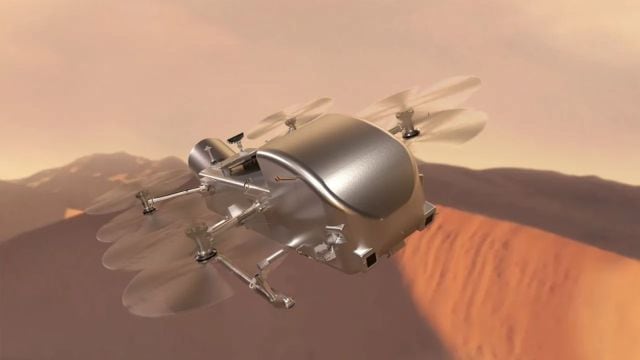NASA confirmed the Dragonfly rotorcraft mission to Saturn’s moon Titan with a budget of $3.35 billion, set for launch in July 2028.
Review and Approval Process:
The Dragonfly mission passed its Preliminary Design Review in early 2023. It was later asked to revise its budget and schedule to align with NASA’s current budget. The updated plan was conditionally approved in November 2023.
Budgetary Changes:
The mission faced a two-fold cost increase and a delay of over two years from its original launch window set in 2019. However, NASA plans to compensate for the delay by providing additional funding for a heavy-lift launch vehicle, reducing travel time to Titan.
Mission Details:
Dragonfly, a car-sized “dual-quadcopter,” will cover tens of kilometers on Titan in under an hour, leveraging the moon’s dense and calm atmosphere and low gravity for efficient travel. Despite being a rotorcraft, it will primarily conduct surface science measurements. Due to Titan’s hazy atmosphere, it will utilize a radioisotope power system for energy, akin to the Curiosity rover on Mars. Operations will primarily occur during daylight to maximize recharging during Titan’s nights.
Significance of Titan:
Titan, Saturn’s largest moon, possesses unique characteristics making it ideal for scientific exploration. It boasts an ocean, a dense atmosphere, and an Earth-like hydrological cycle with methane clouds, rain, and liquid on its surface. The abundance of organic material on Titan makes it a promising site to study habitability and chemical processes relevant to the origins of life on Earth.
Multiple-Choice Questions (MCQs):
- When was NASA’s Dragonfly mission to Titan confirmed?
- A) July 2028
- B) November 2023
- C) Early 2023
- D) 2019
- Answer: B) November 2023
- What compensation did NASA provide for the Dragonfly mission’s delay?
- A) Additional funding for a heavy-lift launch vehicle
- B) Reduction of mission objectives
- C) Postponement of the mission indefinitely
- D) Cancellation of the mission
- Answer: A) Additional funding for a heavy-lift launch vehicle
- What type of power system will Dragonfly utilize on Titan?
- A) Solar power
- B) Nuclear power
- C) Wind power
- D) Hydroelectric power
- Answer: B) Nuclear power
- What makes Titan unique among Saturn’s moons?
- A) It has no atmosphere
- B) It has an ocean
- C) It is the smallest moon
- D) It is devoid of organic material
- Answer: B) It has an ocean
